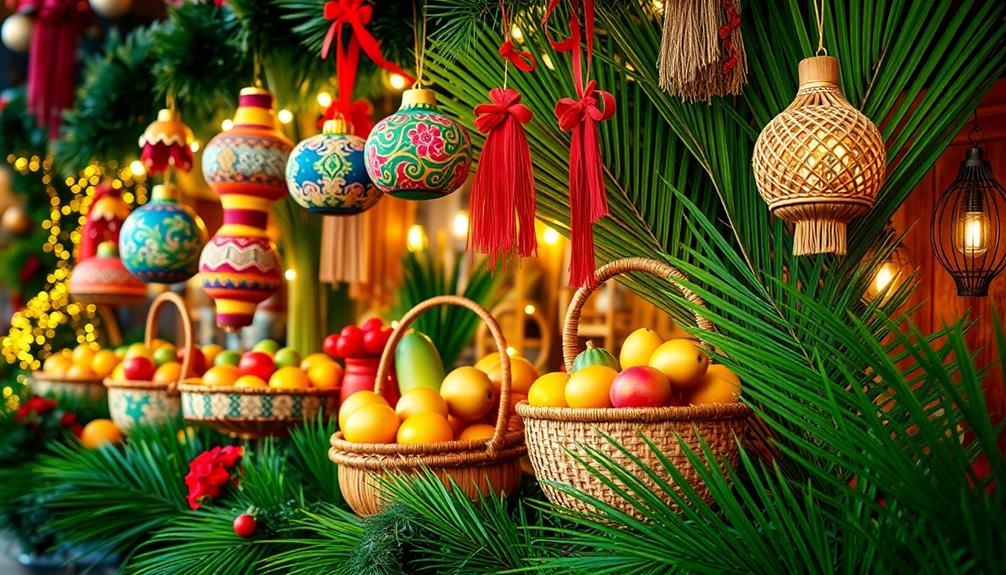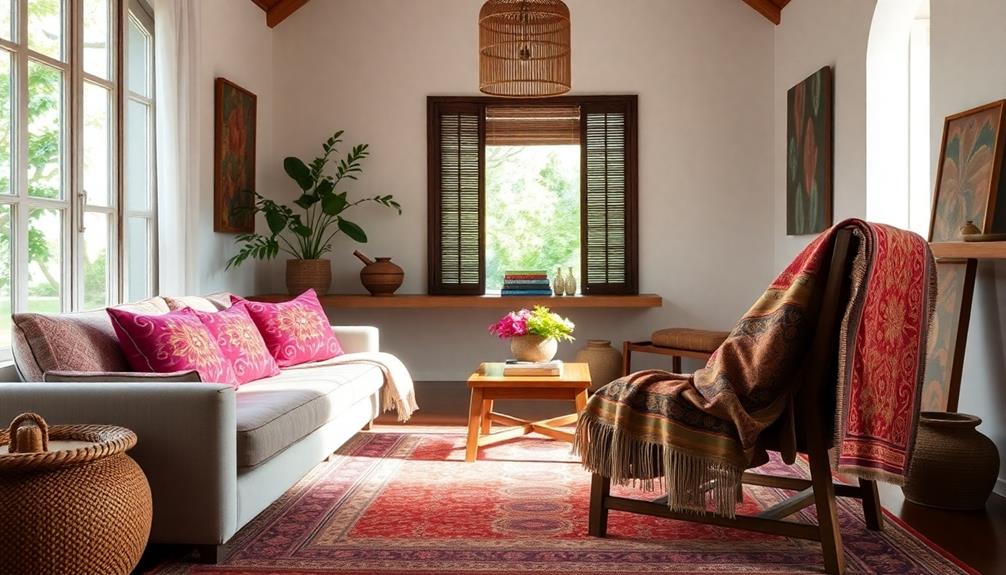You can transform your home into a serene sanctuary by embracing Balinese interior design's magical elements. Start with natural materials like bamboo and teak, creating a connection to nature. Use earthy color palettes that reflect sandy beaches and lush greens to evoke tranquility. Incorporate traditional Balinese art and handcrafted decor for authenticity. Open spaces promote airflow and light, enhancing relaxation. Don't forget to integrate indoor greenery for improved air quality and a vibrant environment. By blending these elements, your home can exude the calm and beauty of Bali's culture, offering a peaceful retreat that awaits your personal touch.
Key Takeaways
- Embrace natural materials like bamboo, rattan, and teak to create durable and eco-friendly furniture that reflects Balinese aesthetics.
- Utilize a calming color palette of earthy tones and soothing blues to evoke the tranquility of Bali's landscapes.
- Incorporate open spaces with large windows to enhance natural light, airflow, and indoor-outdoor connections for a serene atmosphere.
- Add indoor greenery with plants like snake plants and rubber plants to improve air quality and create a vibrant environment.
- Integrate traditional Balinese art and craftsmanship through decorative elements to enhance cultural authenticity and rustic charm in your home.
Core Principles of Balinese Design

The core principles of Balinese design revolve around simplicity and a deep connection to nature. When you embrace this style, you'll find that the use of natural materials—like wood, stone, and textiles—creates a harmonious flow between your interiors and the environment.
This approach not only enhances comfort but also reflects the essence of Balinese design characteristics in your home. Earthy tones dominate the color palette, incorporating soothing blues and lush greens that reflect Bali's breathtaking landscapes, helping to establish a serene ambiance throughout your space.
Open spaces are a key feature, promoting natural light and airflow, which enhances tranquility and encourages a sense of peace. You'll notice how these airy areas blur the boundaries between the indoors and outdoors, inviting nature into your home.
Minimalism plays a vital role as well, allowing for uncluttered living spaces that foster calmness and well-being.
Adding indoor plants further strengthens your connection with the environment, bringing vibrant life and freshness into your decor.
Embracing Natural Materials

When you embrace natural materials in your Balinese interior design, you're not just enhancing aesthetics; you're also fostering a sustainable environment. Utilizing sustainable choices like bamboo, rattan, and teak brings eco-friendliness and durability to your space, making them perfect for both furniture and decor.
Mahallati Interiors is known for creating serene and inviting spaces by expertly blending these materials with modern luxury, innovative tropical designs that reflect the beauty of the surroundings.
Incorporating handcrafted wooden furniture with intricate carvings adds a cultural authenticity that enhances the inviting atmosphere characteristic of Balinese design. The combination of smooth and rough textures from raw wood and stone creates visual interest and depth, allowing you to experience the tactile sensations of Bali's landscapes.
Textiles play a crucial role too. By choosing natural fibers like jute, cotton, and linen, you contribute to a breathable and organic feel, ensuring comfort while celebrating Bali's rich textile artistry.
To elevate the rustic charm, consider adding decorative elements inspired by coconut shells and seashells, connecting your decor to Bali's natural resources.
Color Palette Inspirations

Drawing inspiration from Bali's breathtaking landscapes, a well-curated color palette can transform your space into a serene oasis. Embrace earthy colors like sandy beige, warm browns, and rich terracottas to reflect the natural beauty of Bali and promote tranquility. Incorporate tropical greens such as emerald and forest green in your upholstery and decor, evoking the vibrant greenery of Bali's lush vegetation.
Ocean-inspired blues, from deep ocean hues to light aqua, can add a calming depth to your home. Layer these vibrant colors with softer tones to maintain visual harmony and guarantee that each decor piece complements the overall aesthetic without overwhelming your space. This intentional selection creates a soothing atmosphere reminiscent of Bali's rich cultural heritage and the soothing sounds of nature.
Here's a quick guide to help you with your color palette inspirations:
| Earthy Colors | Tropical Greens | Ocean-Inspired Blues |
|---|---|---|
| Sandy Beige | Emerald Green | Deep Ocean Blue |
| Warm Brown | Forest Green | Light Aqua |
| Rich Terracotta | Lime Green | Teal |
| Cream | Olive Green | Sky Blue |
Let these colors bring the serene essence of Bali into your home.
Cultural Artistry in Decor

To truly embody the spirit of Bali, cultural artistry in decor plays a pivotal role. You can enhance the authenticity of your space by incorporating traditional Balinese wood carvings, which often feature intricate designs and cultural symbols. These pieces breathe life and character into your home.
Additionally, integrating elements from traditional Indonesian style home decor can further enrich your space with natural materials and a harmonious atmosphere. Use vibrant batik and ikat textiles to create visual interest; their rich colors and unique patterns work beautifully in cushions, curtains, and wall hangings.
Handcrafted sculptures and masks that reflect Balinese mythology serve as enthralling focal points and conversation starters, adding depth to your decor. Integrate decorative elements inspired by nature, such as coconut shell and seashell motifs, to evoke a rustic island vibe and connect with Bali's natural resources. These elements remind you of the island's beauty and cultural richness.
Don't forget to include traditional Balinese pottery and ceramics, showcasing the island's craftsmanship. These functional decor items can also serve as artistic accents throughout your space.
Open-Air Living Concepts

Open-air living concepts are a hallmark of Balinese design, seamlessly blending indoor and outdoor spaces to create a harmonious living environment.
You can achieve this by incorporating large sliding glass doors that open up to your outdoor area, inviting natural light and stunning views of the lush landscape. This design not only enhances the aesthetic but also fosters a connection with nature.
To elevate your space further, consider incorporating tropical villa plans that focus on outdoor living areas and sustainability.
Consider using retractable doors to create flexible spaces that can adapt to changing weather conditions, allowing you to enjoy the outdoors in comfort.
Adorn your outdoor areas with tropical plants and soothing water features like ponds or fountains, which add to the serene atmosphere typical of Balinese aesthetics.
Incorporating Indoor Greenery

When you choose indoor plants, you're not just adding beauty; you're also enhancing your space's air quality and calming atmosphere.
Popular indoor plants, such as the Snake Plant, can thrive in low light and require minimal maintenance, making them perfect for any home.
Think about how you can arrange these plants to create a vibrant and inviting environment that echoes Bali's natural charm.
Choosing Indoor Plants
Incorporating indoor greenery is often a key element in achieving the serene ambiance characteristic of Balinese interior design. To enhance your space, consider indoor plants like the bird of paradise and rubber plant, which can beautifully complement Indonesian Decorative Pillows that showcase vibrant colors.
These choices not only elevate aesthetic appeal but also improve air quality and promote tranquility. Opt for plants that thrive in natural light, such as snake plants and pothos, to maximize their growth potential and maintain that calming atmosphere.
To create an immersive environment, utilize decorative plant stands or vertical gardens, which add height and interest while echoing the lush greenery found in Bali's landscapes. This approach fosters a deeper connection to nature, allowing your indoor space to feel more harmonious and alive.
In addition, choose pots made from natural materials like terracotta or woven baskets to maintain the organic feel of your decor. Regularly caring for your indoor plants not only keeps them healthy but also aligns with the Balinese philosophy of harmony and mindfulness.
Benefits of Greenery
Indoor greenery offers a multitude of benefits that go beyond mere aesthetics. By incorporating plants into your home, you'll create a natural and inviting atmosphere that embodies the essence of Balinese design. Additionally, integrating decorative elements such as traditional artistry can further enhance the vibrant feel of your space.
Here are some key advantages:
- Improved Air Quality: Plants like snake plants and peace lilies filter toxins and release oxygen, enhancing the air quality in your living space.
- Reduced Stress Levels: Studies show having indoor greenery can lower stress levels by up to 37%, promoting tranquility and well-being.
- Boosted Productivity: Indoor plants can increase your productivity and creativity by 15%, making your home a perfect blend of relaxation and inspiration.
- Enhanced Humidity: Plants help regulate humidity, making your home more comfortable, especially in dry climates, and reminiscent of Bali's lush environment.
With vibrant colors and natural textures, indoor greenery not only transforms your space but also contributes to a serene and invigorating ambiance.
Embracing these benefits brings you closer to a harmonious living environment that truly reflects the magic of Balinese style.
Placement and Arrangement
To create a harmonious Balinese-inspired space, strategically placing and arranging your indoor greenery is essential. Start by positioning your plants in well-lit areas near windows to maximize natural light, promoting healthy growth and enhancing your home's ambiance.
Incorporating elements of modern tropical aesthetics can further elevate the design, as it emphasizes the seamless blend of indoor and outdoor environments. Layering heights adds visual interest; incorporate floor plants, tabletop arrangements, and hanging planters to craft a lush, inviting atmosphere.
Grouping plants in clusters fosters a mini indoor garden effect, enhancing aesthetics while improving air quality. Use larger plants like snake plants or rubber trees as focal points in your living areas. These plants anchor the space and draw the eye, creating a sense of harmony with nature.
To truly capture tropical vibes, consider adding bold varieties such as bird of paradise and dracaena. Their vibrant colors and natural textures evoke the lush landscapes of Bali, infusing your home with an enchanting feel.
Creating Serene Spaces

Creating a serene space involves carefully selecting elements that foster tranquility and connection to nature. When you focus on creating a sanctuary within your home, consider the following:
- Calming Color Palette: Use earthy tones and soothing blues that reflect the tranquility of Bali's landscapes, crafting an ambiance that relaxes your mind. Incorporating vibrant accents, such as a unique Indonesian decor mask, can also enhance the cultural essence of your space.
- Natural Materials: Incorporate bamboo, rattan, and wood to enhance the aesthetic appeal while promoting a deeper connection to nature. These materials create a peaceful environment that feels grounded.
- Open-Air Living Spaces: Utilize large windows and sliding doors to blur the boundaries between indoor and outdoor areas. This enhances natural light and airflow, contributing to a tranquil atmosphere.
- Indoor Plants: Add lush greenery with indoor plants like rubber plants and snake plants. They not only improve air quality but also bring a sense of liveliness and connection to nature.
Mindfully selected decorative elements, such as Balinese textiles and handcrafted artifacts, infuse your home with cultural richness while promoting calm and relaxation.
Embrace these elements to create a serene space that nurtures your well-being.
Practical Tips for Implementation

To bring Balinese interior design to life, start by choosing natural materials and a harmonious color palette that reflects the earthy tones of the island.
Incorporating elements like luxury tropical designs can elevate the overall aesthetic.
Focus on integrating indoor and outdoor spaces to create a seamless flow and enhance your home's ambiance.
These practical tips will help you capture the essence of Balinese style while ensuring a serene living environment.
Natural Material Selection
How can you effectively incorporate natural materials into your Balinese interior design? Start by choosing eco-friendly options that reflect the beauty and durability of Balinese aesthetics.
Here are four practical tips to help you achieve that tranquility you're after:
- Select Sustainable Materials: Use bamboo, rattan, and teak for furniture and fixtures. These natural materials not only look stunning but also last long.
- Incorporate Natural Textiles: Opt for upholstery made from jute, cotton, or linen. These textiles enhance comfort while adding an organic touch to your space.
- Create Contrast in Textures: Mix rough-hewn woods with smooth finishes. This contrast in textures adds visual interest and depth, making your interiors feel dynamic.
- Invest in Handcrafted Furniture: Seek out pieces that celebrate local craftsmanship. Handcrafted furniture adds authenticity and connects your home to Balinese culture.
Color Palette Harmony
Natural materials set the stage for a serene environment, but the color palette plays an essential role in completing your Balinese interior design. Start with a neutral base using warm browns, sandy beiges, and soft pastels to create a tranquil backdrop that reflects Bali's natural landscapes. This allows vibrant colors to stand out without overwhelming the space.
Introduce tropical greens and ocean blues in your upholstery or decor to evoke the freshness of Bali's lush scenery and serene waters. These hues add vibrancy while maintaining a sense of calm.
Layer your colors thoughtfully by combining earthy tones with brighter accent hues like reds and yellows. This approach maintains visual interest while preserving that calming atmosphere you desire.
Make the most of natural light, as it enhances the richness of earthy tones and creates an inviting ambiance.
Finally, consider using textiles with batik prints as statement pieces. They not only add cultural authenticity but also serve as focal points that harmonize beautifully with your chosen color palette.
Indoor-Outdoor Integration
Seamlessly blending indoor and outdoor spaces is essential for achieving that quintessential Balinese vibe in your home. You can create a tranquil atmosphere and enhance indoor-outdoor integration by following these practical tips:
- Install large sliding glass doors or retractable walls to facilitate seamless connections between your indoor living areas and outdoor spaces. This enhances airflow and floods your home with natural light.
- Incorporate outdoor living areas like patios or decks, furnished with comfortable seating and lush greenery. This encourages relaxation and a deeper connection with nature.
- Design courtyards or gardens visible from key living spaces. Integrating lush vegetation and water features promotes tranquility and creates a serene atmosphere throughout your home.
- Use natural materials such as stone or wood in both indoor and outdoor areas. This fosters a cohesive aesthetic that mirrors Bali's landscapes and enhances the harmony of your space.
Frequently Asked Questions
What Are the Key Elements of Balinese Furniture Design?
When considering Balinese furniture design, you'll notice key elements like natural materials, intricate carvings, and a focus on harmony with nature. These aspects create a warm, inviting atmosphere that reflects Indonesia's rich cultural heritage.
How Can I Balance Modern and Traditional Balinese Styles?
To balance modern and traditional Balinese styles, mix sleek furniture with handcrafted pieces. Incorporate natural materials like wood and stone, and use vibrant textiles alongside neutral tones to create harmony and warmth in your space.
What Types of Lighting Are Best for a Balinese-Inspired Room?
What's better than warm, ambient lighting to transform your space? Use soft, natural materials like bamboo or rattan with dimmable fixtures. Incorporate lanterns and candles to create a cozy, inviting atmosphere that resonates with Balinese charm.
Are There Specific Plants That Enhance Balinese Interior Design?
Incorporating plants like frangipani, bamboo, and palm trees can enhance your space. They bring a tropical vibe, improve air quality, and create a serene atmosphere that perfectly complements your Balinese-inspired design.
How Do I Care for Balinese Decor Items?
Caring for Balinese decor items is like nurturing a delicate garden. Dust them regularly, avoid harsh chemicals, and keep them away from direct sunlight. With love and attention, they'll maintain their beauty for years to come.
Conclusion
To truly embrace Balinese interior design, remember that "home is where the heart is." By integrating natural materials, a soothing color palette, and lush greenery, you can create tranquil spaces that reflect this enchanting style. Open-air concepts and cultural artistry will invite serenity into your home, fostering a connection with nature. With these practical tips, you'll uncover the magic of Balinese design, turning your living space into a peaceful retreat that nurtures your soul. Incorporate handcrafted textiles and intricate woodcarvings to make a bold statement with textures, adding depth and character to your Balinese-inspired space. These details will further enhance the ambiance, creating a sense of warmth and tranquility that embodies the essence of Balinese interior design. By paying attention to these finer elements, you can truly capture the spirit of this captivating style and transform your home into a sanctuary of relaxation and harmony. To unlock the full potential of Balinese interior design, embrace the principle of balance and harmony. Incorporate elements of yin and yang, such as blending light and dark tones or mixing traditional craftsmanship with modern amenities. Another key to achieving the essence of Balinese interior design is to pay homage to the island’s spiritual traditions. Integrate symbols and motifs such as lotus flowers, mandalas, or Hindu gods and goddesses to infuse your space with a sacred and peaceful energy. By honoring these Balinese interior design secrets, you can create a home that not only reflects the beauty of the island but also nourishes your mind, body, and spirit.










